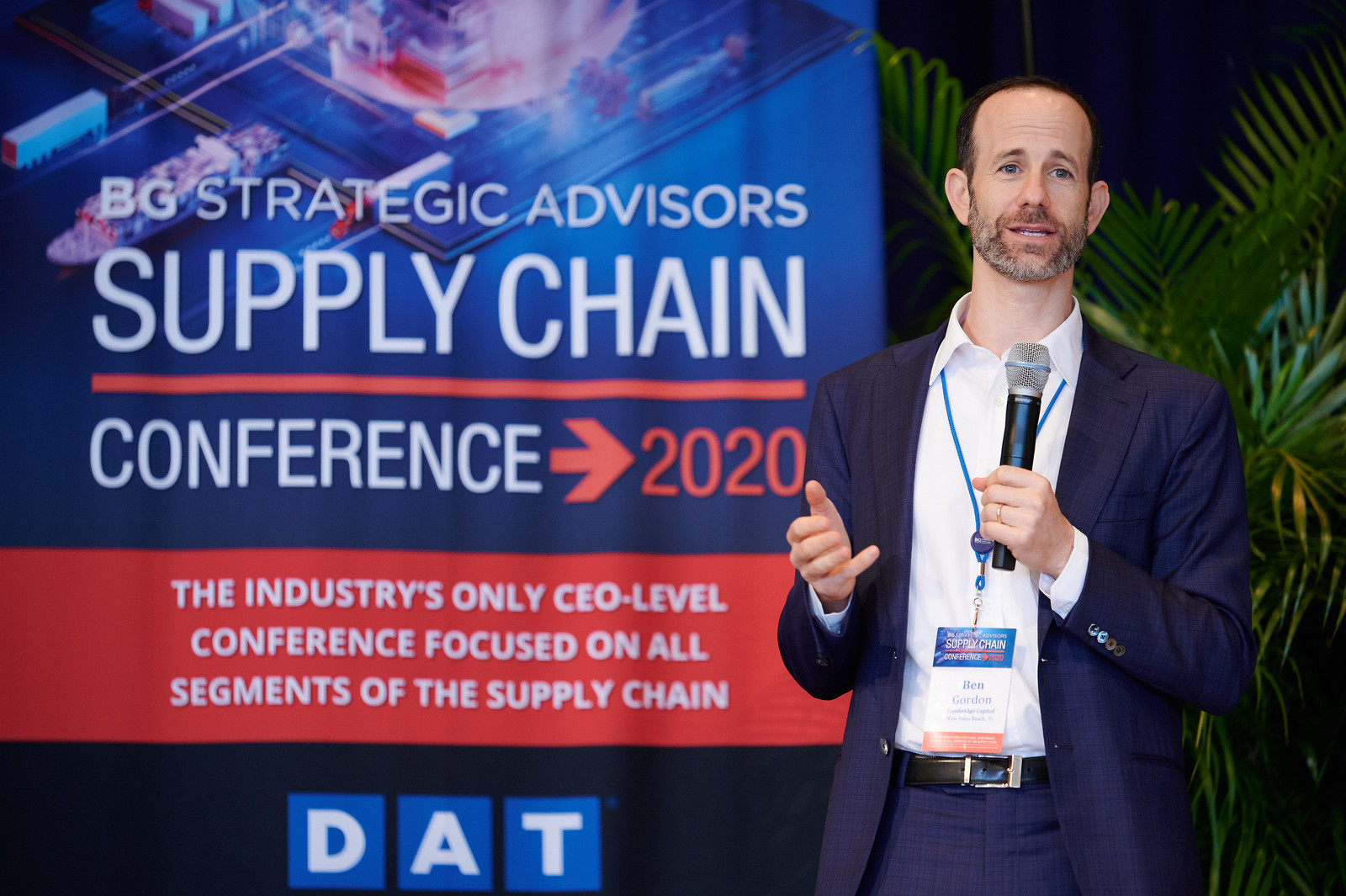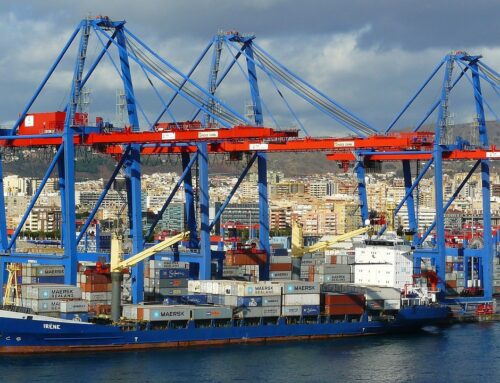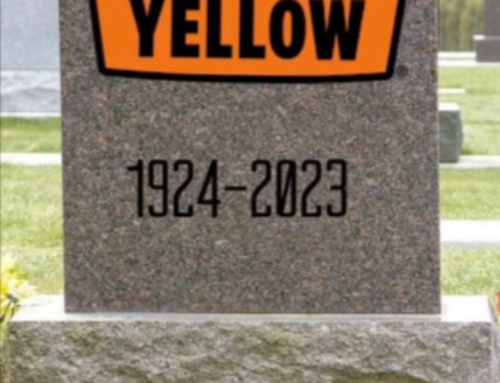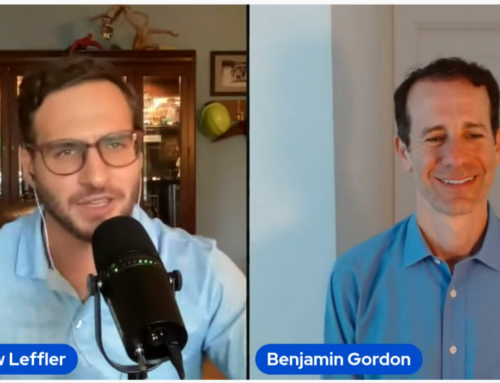
By Jeff Berman, Group News Editor, Logistics Management · January 23, 2020
This week, the 14th annual BG Strategic Advisors annual conference, BGSA Supply Chain Conference 2020, kicked off at The Breakers in Palm Beach, Fla. This event positions itself as the “only CEO-level event focused on all segments of the supply chain” and takes a deep dive into myriad facets of the industry, including technology innovation, global growth, the state of logistics, the state of trucking, and dealmaking spotlights, among others. Logistics Management Group News Editor Jeff Berman recently caught up with Ben Gordon, Managing Partner of Cambridge Capital, an investor in niche supply chain leaders and also Managing Partner of BGSA Holdings, a leading mergers and acquisitions advisory firm focused on the transportation, logistics, and supply chain technology sector, about this week’s conference and the current state of supply chain and logistics M&A activity. A transcript of the conversation follows below.
Logistics Management (LM): What are the big focus areas of this week’s BGSA Supply Chain conference?
Ben Gordon: The big topics, of course, are capital markets and technology. There are lots of M&A and investment topics to discuss and on the technology side I think every logistics company is worried about how to make sure they use technology to stay competitive, and every technology company wants to make sure that they can win logistics companies as customers and allies. It is a very interesting story on both sides.
LM: A few years back, you talked about the concept of “service convergence,” in which one company acquires another to get something it needs as a service offering for its customers. Does it still serve as a good working theme or has the script shifted in different ways for various reasons?
Gordon: Convergence, which was a huge driver of so much of the M&A over the last decade, probably reached its crescendo with XPO Logistics.
LM: In what ways?
Gordon: The premise of XPO was to buy and combine great services in different areas of logistics so whether that is truck brokerage, intermodal, warehousing, value-added services like brokerage as well as managed transportation. Those are all key elements, and I think XPO’s premise was to buy, integrate, cross-sell and achieve convergence. I think they did a good job of it. If you look at the actual data and look how many customers they were able to achieve cross-selling benefits with after acquisition, I actually think they did pretty well. The fact that [XPO Chairman and CEO] Brad Jacobs is exploring breaking it up suggests it was not as integrated as we thought….but it is all speculative as at this point it is just an announcement. It may be that years from now we will look back on the history of U.S. logistics, and we find that 2020 was the peak of convergence…and that the XPO divestiture, if it indeed does occur, could mark the transition point.
LM: How would it mark the transition point?
Gordon: It is not just because of XPO. I think it is also that it has been harder than many people expected to achieve cross-selling. One classic example was when Wilpak was sold to Jacobson in May 2006, it marked a combination of contract packaging with contract warehousing. That seemed like a classic fit for a convergence play, because you had two sets of services—in packaging and warehousing—and you could go to the same customer and in some cases you could go to different locations and simply be eliminating shuttling costs by co-locating those services. That kind of convergence seemed like a natural fit. Similarly, it felt like a natural fit to combine truck brokerage and intermodal, as was the case when XPO acquired Pacer, which was easy.
LM: What are some other examples?
Gordon: A combination of warehousing plus freight forwarding or Customs brokerage. When Ozburn-Hessey bought Barthco in July 2006, it was an example of a convergence effort that, in the end, was not as successful of some of the other examples we talked about. It was not because of the people, it was because those services are harder to bundle. The convergence that has driven so much of the M&A over the last ten-to-15 years was real, but I think some of it proved to be a bridge too far.
LM: Looking at the logistics and freight transportation markets now, there are a lot of new players that have made significant entrances and inroads that were not in existence even a decade ago or less. While these companies are quickly becoming established, they are not making M&A deals, it seems. Will that change over time and can a smaller emerging company do, for example, what XPO has done on the path to growth?
Gordon: Absolutely. In fact, some of the most successful companies that I know are taking pages from the XPO playbook. I look at GlobalTranz. GlobalTranz has bought 11 companies over the last 2.5 years. The success of that will be measured probably a year or two from now. Fundamentally, they have been doing acquisition-like growth. And, like XPO, it has been very aggressive and systematic. At our conference last year, I did an interview with Bob Farrell, GlobalTranz chairman, about how he did it with a very systematic approach. On the other hand, its approach is narrower than XPO, because it is really only buying brokerage and managed transportation and is not doing the broader plays XPO did with international- or trucking-based deals. I would say GlobalTranz borrowed from the XPO playbook, in terms of an aggressive, repeatable, systematic acquisition plan, but it was narrower in the scope of what it did. It is too soon to declare total victory on that, but historically it has been very successful with that strategy.
LM: Looking at the nature of different deals, many large companies made tuck-in acquisitions to fill a specific need or niche. What is the current state of these types of deals?
Gordon: I think there has been a steady diet of tuck-ins, but they have been quieter and have generally involved private companies as opposed to public companies. I have not seen larger companies like C.H. Robinson or Echo Global Logistics or some of the others pursue tuck-ins lately. But GlobalTranz is an example having just acquired Cerasis, and Transplace is another with its recent acquisition of LaneHub. Sale numbers were not disclosed for either deal, but I can tell you they were both well below ten percent the size of the acquirer. So, if you are Transplace buying Lanehub, you are adding a great collaboration network of about 150 shippers, 150 carriers, and $23 billion in truckload spend. They are getting network reach, but it is a relatively small and successful acquisition. It does not have to go raise financing or worry about the risk of making a gigantic acquisition. It is a classic tuck-in acquisition, as is the GlobalTranz-Cerasis deal. With the Global Tranz-Cerasis deal, most of that deal fit the [tuck-in] profile, in terms of being below ten percent the size of the acquirer, easy to integrate, and being consistent with the overall strategy of the business and therefore relatively simple and consistent with the rest of the service footprint.
LM: What is a good example of a larger company making a tuck-in acquisition?
Gordon: When Echo bought Command a while back, that was viewed as transformative and big. And you could argue in hindsight that Echo, which has bought close to 20 companies, has had great success with small tuck-ins. Command was a harder deal because of the magnitude, the purchase price, and the integration requirements. It can be successful either way, but I think we have seen more tuck-ins than transformative acquisitions over the last year and that is probably a good thing for the likelihood for success.
Hub Group acquired CaseStack in December 2018 for $252 million, MODE in August 2018 for $258 million, which were bigger than your average small tuck-in, but Hub Group’s total enterprise value today is $2 billion and has gone up a little bit since the time of those deals. These deals were in the 10%-to-20% of the enterprise value range….but not so big or different that they were totally transformational. Hub’s acquisition of Estenson Logistics was in 2017 and that was a $306 million deal in dedicated freight. That one surprised me a little bit because Hub is an intermodal marketing company and asset-light, and Estenson is dedicated freight. Hub has made three acquisitions in the last 2.5 years, totaling more roughly $800 million in M&A. That is actually a lot. I would not say Hub has been as acquisitive as XPO but quietly it has become pretty aggressive for a company that historically has bought very little.
LM: What is your take on Amazon getting into this space on the M&A front?
Gordon: I think Amazon will continue to invest very aggressively to build out its logistics position. But the best analogy I see for Amazon is what it did with Amazon Web Services (AWS), which really came into existence less than 15 years ago. In the beginning, AWS was a service for its existing customers, and it expanded to become a full-service, arm’s length standalone business unit. This was done through aggressive investment, but it was not done through acquisition. If AWS holds true as an analogy, then you could see Amazon continuing to pour tremendous resources in the form of hiring people and spending money on technology, building out services and building its own network like it is doing in last-mile right now. It is not as likely to be an acquirer, but Jeff Bezos is really the only one that knows that. The evidence I see seems to suggest it will follow the AWS path.
————————
Benjamin Gordon is Founder of Cambridge Capital and BGSA. He is a leading investor in logistics, technology, and supply chain. For more on the BGSA Supply Chain Conference, visit here.









